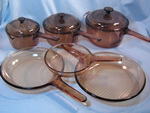|
Choosing Cookware From A Wide SelectionChoosing cookware for your kitchen needs can be a daunting task, not only are there a variety of pots and pans to choose from, but a variety of materials to choose from as well.
The basic kitchen should start with two sauce pans with lids, a 1quart and 2 or 3 quart size with lids, two skillets a 10 inch or 12 inch size with lids, an 8 or 9 inch sauté/omelet pan with lid, a shallow roaster, a 5 quart or larger Dutch oven, a stockpot 4 quarts or above, a double boiler, a steamer insert basket, and a griddle at the minimum, with additional pots and pans being added as needed.
The qualities of a good set of cookware are the ability of the cookware to heat up quickly and to distribute heat evenly over the cookware for consistent cooking. The quality of the cookware is determined by the type of material the cookware is made of and the thickness of the material. Some other things to consider when choosing cookware are: 1) how much do you have to spend; 2) how much will you be cooking; 3) what types of foods you will be cooking; and 4) how many people you will be cooking for on a regular basis. What are the different types of cookware for consideration?
Aluminum When choosing cookware aluminum is a relatively inexpensive lightweight cookware with good heat conductivity; however aluminum can react with acidic cooking ingredients and does tend toward corrosion. The reactivity with acidic ingredients does cause aluminum to affect the taste of foods adding the taste of the metal to the food. On another note although there is no definitive evidence some believe that aluminum contributes to the cause of Alzheimer’s and should not be used on a regular basis for general use cooking. As a result of the drawbacks that have been found with cooking with aluminum, to preserve the best features of aluminum, this metal is also found in coated forms today to minimize the concerns with the risks of using this metal and to alleviate the reactivity with the metal in cooking. Best Uses : Cooking non-acidic foods, such as pasta or making stock. Cleaning : Use a mild detergent with a dish cloth or sponge with hot water. Aluminum cookware shouldn’t be placed in the dishwasher but should be washed by hand. Cast Iron When choosing cookware cast iron is one of the oldest forms of cookware, and is a very heavy material that must be seasoned periodically, generally with shortening, but is a good heat conductor once it heats up since the material is slow to heat, and can withstand high temperatures. Cast iron does however rust easily and is reactive with acidic ingredients. Cast iron tends toward the inexpensive to moderately expensive. Best Uses : When properly seasoned cast iron is good for deep frying, braising, baking and slow cooking. Cleaning : Cast iron should not be washed with soap and water, but with plain water, dried thoroughly to prevent rusting and re-seasoned with shortening after every use. Ceramic/Enamel When choosing cookware ceramic cookware has the property of even heat distribution and can tolerate fairly high temperatures, also has some nonstick properties which make it easy to clean. Ceramic surfaces do resist natural wear and corrosion; however ceramic cookware can chip over time. Ceramic cookware can go from oven or stove stop to the table for serving since ceramic cookware often comes in beautiful colors and designs, and can be safely stored in the refrigerator after use.
Best Uses : Baking and preparing meals in the microwave. Cleaning : Ceramic cookware can be safely washed in the dishwater for easy cleanup. Copper When choosing cookware copper cookware is probably one of the best metals for conducting heat; however, copper is reactive with foods and is toxic in large amounts, therefore copper is often coated with another material to lessen the amount of leaching of copper into the food. Copper also dents and discolors easily and must be polished constantly to keep it looking good. Best Uses : When properly lined to prevent leaching of copper into the food, due to its excellent heat conductivity, copper can be used for all stovetop preparations. Cleaning : Due to its easy discoloration copper should not be washed in the dishwasher. Hard Anodized Aluminum When choosing cookware due to the problems with uncoated aluminum hard anodized aluminum was developed by adding a special coating to protect the inside of the cookware from corrosion and leaching aluminum into the food. The special coating makes the cookware behave as a nonstick. Hard anodized is also a good heat conductor. Best Uses : This type of cookware should not be used for highly acidic or alkaline foods but can be used for almost any other type of cooking.
Cleaning : Hard anodized should not be placed in the dishwasher, and should be cleaned by hand with hot soapy water, and abrasive materials should not be used on the cooking surface. Nonstick When choosing cookware nonstick cookware has a coating applied that began with Teflon by which PTFE (polytetrafluoroethylene), which has properties of heat resistance and now includes others. PTFE is non-reactive and stable until it reaches a temperature range of about 260 degrees centigrade which is 500 degrees Fahrenheit, which is why nonstick cookware shouldn’t be heated to high temperatures and don’t often do well on some of the more modern cook stove. Nonstick cookware also has coatings composed of PFOA (perfluorooctanoic acid) as a result of PTFE use in coatings for nonstick cookware. As a result there have been efforts to create nonstick cookware eliminating the use of these compounds and one result has been the creation of a ceramic nonstick called Thermolon, which gives lovers of nonstick cookware a new option since the cookware heats up quickly and can go to very high temperatures such as 450 degrees centigrade or 850 degrees Fahrenheit.
Best Uses : Nonstick cookware is good for cooking food items such as omelets where the temperatures don’t have to go very high and for reheating foods. In addition, cooking utensils that are wood, plastic, nylon coated or silicon coated should be used for stirring and removing food not stainless steel since it can scratch the nonstick surface. Cleaning : Due to the nonstick coating cleaning is generally easy with the use of hot soapy water and avoidance of abrasives since these can remove traditional nonstick coatings, and nonstick cookware should not be cleaned in a dishwasher. Stainless Steel When choosing cookware stainless Steel is considered by many to be the best general purpose cookware, due to its characteristics of being lightweight, durable, non-tarnishing and non-corroding. However, stainless steel isn’t a good heat conductor and doesn’t distribute heat evenly which is why it often has copper or aluminum sandwiched between layers of stainless steel on the bottom of the cookware to increase its heat conductivity. Stainless steel is also non-reactive with acidic and alkaline ingredients. Best Uses : When copper or aluminum is sandwiched between stainless steel on the bottom of the cookware, an excellent choice for all types of cooking.
Cleaning : Stainless steel is dishwasher safe, but does tend to become dull and discolored, when this occurs a good stainless steel cleaner will restore the luster of the cookware. When hand washing stainless steel should be cleaned with hot soapy water and a nylon scouring pad or nylon scraper can be used to remove stuck on food, which is one of the drawbacks to stainless steel food can really stick to the surface so the surface. Stoneware When choosing cookware stoneware is a type of cookware made of kiln-fired clay at high temperatures which allows for even heat distribution for this type of cookware, which also retains heat for a long period of time to keep food warm. This type of cookware is generally thought of as being used to bake pizzas but can be used for just about any types of food in both the oven and the microwave. Stoneware should also be seasoned with vegetable oil prior to use to create a nonstick surface. Stoneware should be cooled down thoroughly before placing it in the refrigerator otherwise it will crack.
Best Uses : Can best be used for any foods that can be cooked in an oven or microwave, especially pizza.
Cleaning : Stoneware is cleaned by allowing it to cool down first then running hot water over the cookware and scrapping off food that has stuck to the cookware. Soapy water should not be used since the stoneware will absorb the soap and pass this taste along to any food that is subsequently cooked. Tempered Glass When choosing cookware glass cookware can be used on the stove top in the oven and the microwave, but glass heats unevenly and can thus cause food to stick to the cookware, but sticking can be reduced by spraying glass cookware with cooking spray before each use. Care must be taken with glass cookware since it is breakable Best Uses : Glass cookware is best used for baking and microwave cooking, but even in the microwave the cookware should not be allowed to run out of liquid since allowing the cookware to dry out can cause cracking. Cleaning : Glass cookware is safe for washing in the dishwasher and can also by cleaned by hand using a mild solution of dishwashing soap. Steel wool scouring pads are great for removing stubborn encrusted food.
• The Taste of Home Cookbook – All New Edition from Taste of Home Books, Reiman Media Group • The All New Good Housekeeping Cook Book, Edited by Susan Westmoreland, Hearst Books, New York • Betty Crocker Cookbook – New Edition, by Wiley Publishing, Inc. • The Food Encyclopedia by Jacques L. Rolland and Carol Sherman with other contributors • The Complete America’s Test Kitchen TV Show Cookbook 2001-2010 by The Editors of America’s Test Kitchen
Cooking Basics
|
Cookware Variety
Aluminum Cookware
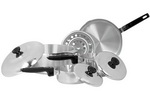
Cast Iron Cookware
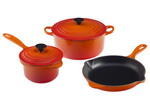
Ceramic/Enamel Cookware
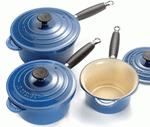
Copper Cookware
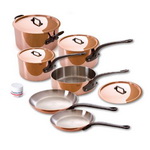
Hard Anodized Aluminum
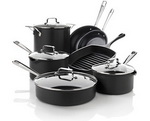
Nonstick Cookware
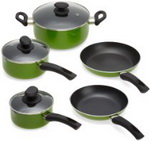
Stainless Steel Cookware
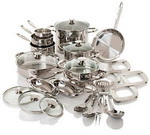
Stoneware Cookware
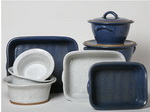
Tempered Glass Cookware
